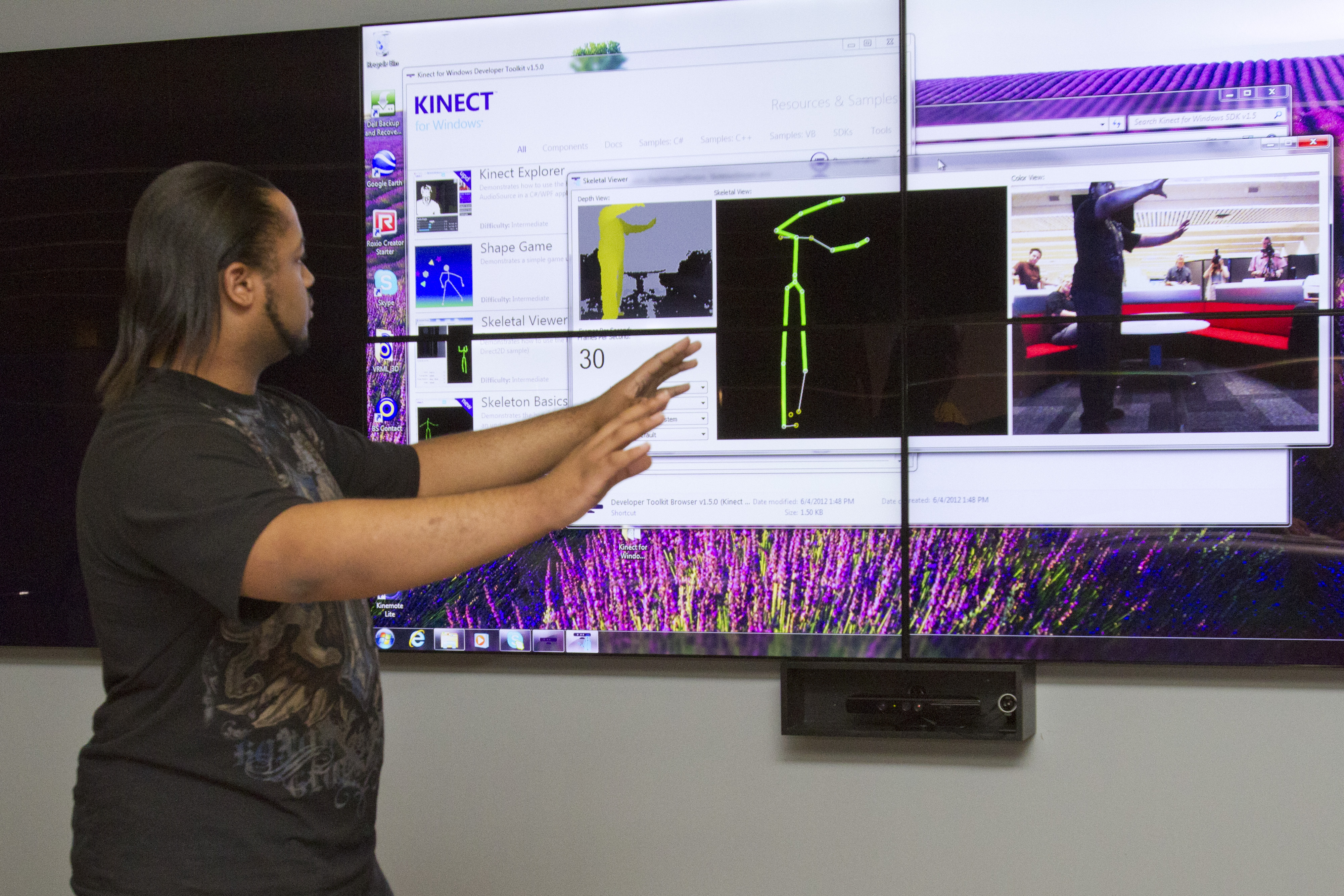The winged “Aviator” statue outside of the University of Virginia’s Clemons Library has taken flight into cyberspace, and soon may fly through the scenes of a student film, or land on a nearby desk, thanks to a suite of new state-of-the-art digital tools at the library’s Robertson Media Center.
The new tools were acquired over the summer as part of an $815,000 Teaching and Learning Spaces Award funded in last year’s university budget.
To demonstrate some of the potential of the new tools, which now fill the majority of the third floor of Clemons Library, center staffers used the library’s new mobile FARO 3-D laser scanner to scan the entire surface of the statue, creating a perfect digital replica, explained Jama Coartney, the center’s media ecosystem project manager.
The virtual statue can now be animated, manipulated, replicated, visualized or mapped in myriad ways using the rest of the new digital tools, Coartney said. For instance, the statue could be animated using the center’s new Hollywood-standard 3-D modeling and animation software (Maya and 3D Studio Max), perhaps by melding the digital statue with a student actor’s flapping-wing motions, captured on a green screen with the center’s new portable motion-capture system.
The statue could become part of an entirely online virtual museum, alongside other digital models of famous statues and buildings from around the state, or around the world.
The digital statue – in flight or at rest – could also be viewed on an immersive, wrap-around virtual-reality display, a sort of personal IMAX theater, Coartney said, or seen in 3-D on a 16-foot-wide display array with 16.5 million pixels, one of the largest active-shutter 3-D display arrays in the world and the centerpiece of a new visualization lounge with tiered seating for 16.
The “viz lounge” also features a Microsoft Kinect, which enables control of on-screen items with gestures and spoken commands. A student could stand in front of the 3-D display array and use Kinect to control a wireframe on-screen model of the statue, bringing it to life in real-time, perhaps as part of a drama or studio art class.
One could even fabricate a tangible scale model of the statue in the new Rapid-Prototyping Laboratory in the School of Engineering and Applied Sciences' Mechanical and Aerospace Engineering Building, home to seven sophisticated 3-D printers, including a $120,000 Fortus precision printer that can extrude the statue in plastic. Two milling machines and a laser cutter can cut a model of the statue from a block of wood, a cube of steel or other materials.
(Anyone can place an order with the lab. Material and service charges apply, generally ranging from $7.50 to $10 per cubic inch of material, lab engineer Dwight Dart said.)
Other new award-funded additions to Clemons’ third floor include a 20-seat computer classroom featuring rolling desks equipped with high-end computers and large monitors or dual monitors. A few yards away, two new Media:scape tables enable small groups to connect up to six laptops and take turns controlling the dual central monitors, to facilitate discussion and demonstration.
The center also has a new 52-inch multi-touch display that functions like a giant iPad, Coartney said.
All of the center’s new tools are free and available to the whole U.Va. community. Some of the most sensitive or expensive tools, like the FARO 3-D laser scanner, require specialized training, handling or supervision, Coartney said.
These new tools are applicable to a variety of teaching, learning and scholarship contexts, said Will Rourk, an information visualization specialist at the center. The Robertson Media Center is now one of the only places in North America where one center, open to an entire University community, has such a collection of 3-D technology tools, he added.
“This is about taking the analog world around us, and digitizing it,” he said.
The library “made a strategic investment in disruptive technologies,” like the combination of 3-D scanning and printing, with “game-changing potential” that is just beginning to be realized, Coartney said.
The library is guided by a philosophy of purchasing digital tools that are cutting-edge, but not quite leading-edge – second- or third-generation products that have been around long enough to dramatically improve and drop in price, making them far more sustainable for the library, Rourk said. A good example is the new immersive, wraparound virtual reality display, roughly 6 feet wide – a model used primarily by the military and available at just a handful of colleges in North America. That display alone would have cost more than $1 million a decade ago, but now costs about $50,000.
The $815,000 award also paid for four new "transformed spaces": two new flexible teaching, presentation and study spaces in Alderman Library and the Brown Science and Engineering Library; a new digital visualization space in the Fine Arts Library; and a Teach Anywhere! mobile cart of 20 iPads intended to enhance the technology capabilities of non-computer-equipped classrooms anywhere around Grounds, said Charlotte Morford, the library's director of communications.
The Robertson Media Center, which opened in 1999, was made possible through a $1.2 million gift from Timothy B. Robertson, a 1977 University alumnus and member of the Board of Visitors, and his wife, Lisa Nelson Robertson.
Media Contact
Article Information
October 3, 2012
/content/library-offers-new-trove-3-d-digital-tools

